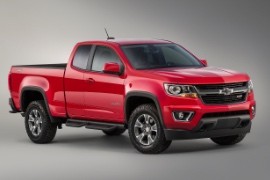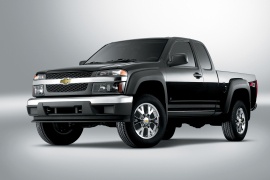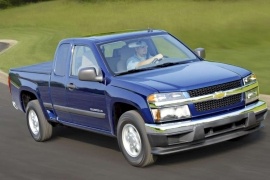CHEVROLET Colorado Extended Cab Models/Series Timeline, Specifications & Photos
First production year: 2003
Engines: Gasoline
Body style: Truck
When the GM and Isuzu joined their forces to built reliable workhorses on four wheels, they also agreed who will sell where. And the GM had the U.S. This is how Chevrolet Colorado ended up having the same chassis as an Isuzu D-Max.
The Chevrolet Colorado was the kind of truck that could be used as a daily driver and a weekend companion. The 2015 model received the "corner step" introduced for the first trim in the Chevrolet Silverado, which had sculpted steps inside the rear bumper to help climbing in and out of the bed. The front fascia was flat and tall. The Extended Cab was available with a 6 feet bed. (1.82 m) and it could tow up to 6,700 pounds (3,039 kg).
The Extended Cab had two rear-hinged doors that provided access to the rear seats. Those were moreover large enough to install child-seats since the legroom was virtually none. Inside, the dashboard was closer to an SUV than to a utility truck. And the vehicle was good to serve well for both purposes. In the center console, a new infotainment system was installed and was able to connect via Android Auto and Apple CarPlay with virtually any smartphone.
Under the hood, Colorado had three engine choices, depending on the market. The standard model featured a 2.5-liter gasoline engine, while the top version had a 3.6-liter V6 unit installed. Both were mated as standard with a 6-speed manual and a 6-speed automatic was available as an option. In some countries, there was a 2.8-liter Duramax turbodiesel engine.
General Motors introduced the second generation of Colorado in 2009, after a joint project made with Isuzu, which brought a few other vehicles on the market.
GM worked together with Isuzu to develop the Chevrolet Colorado/Isuzu D-Max lineup and, in 2003, it represented a very good deal in the compact pickup segment. It even used the same chassis to built the smallest Hummer on the market, named the H3. With money going out of its pockets, and after it lost the Saab and Opel brands in Europe, GM had to strengthen its position in its home market, and a refreshed pickup was considered a solution. And it worked.
Chevrolet Colorado was available in three cabin sizes, with the Extended Cab as the middle road between the workhorse Regular Cab and the family-oriented Crew-Cab. There was a new front fascia for the Colorado, which was inspired by its bigger brother, the Silverado. Depending on the trim level, it featured a body-colored horizontal bar between the headlights that crossed over the grille and supported the bow-tie badge. On the upper trim level, the carmaker offered that bar along with the bumpers in chromed finish. The Extended-Cab version featured a pair of rear-hinged doors in the back.
Inside, the carmaker offered a base model with automatic transmission for the U.S. market but with cranked windows and a manual air-conditioning system. The rear jump-seats were good only for short or very short distances and mainly for short-legged people. On the plus side, that area was great for storage.
Under the hood, Chevrolet offered a choice of three engines ranged between 185 hp and 300 hp. Only the base model was available with a five-speed manual, while the carmaker paired the other two to a four-speed automatic.
Chevrolet introduced the Colorado lineup in 2003 as a 2004 model year and continued its tradition in the light-duty pickups, competing against Ford Ranger and Dodge Dakota.
General Motors had its stakes in the Isuzu and started a joint project with the Japanese company. That resulted in a few vehicles, including the Isuzu D-max and the Chevrolet Colorado. The latter was available in a few cab versions, with the Extended-Cab placed in the middle.
The car's front featured a distinct front fascia with a horizontal slat that crossed the vehicle from one side to another, splitting the headlights in two. Depending on the trim option, that slat was chromed or body-colored. In the Extended Cab version, the Colorado featured a set of suicide-doors in the back. Thus, the carmaker eased-up the ingress and egress to the car for the rear passengers. Behind the cabin, Chevrolet installed a long bed. Interestingly, the Extended-Cab was the longest in the lineup.
Inside, Chevrolet installed a bench-seat on the base trim level or bucket seats. On the versions fitted with a manual gearbox, the gear-stick was installed on the center console. For the automatic version, the carmaker moved the lever on the steering column. The rear seats offered limited room for two passengers, mostly for short distances.
Under the hood, the bow-tie brand installed a wide range of engines ranged between the fuel-efficient inline-four 2.8-liter unit and a beefy 3.7-liter inline-five. The latter was unusual for an American pickup. Yet it was offered, and even though it was not sold in large numbers, it impressed with its pulling power.
CHEVROLET Colorado Extended Cab 2.8L 4AT (175 HP)
CHEVROLET Colorado Extended Cab 2.8L 5MT (175 HP)
CHEVROLET Colorado Extended Cab 2.9L 5MT AWD (185 HP)
CHEVROLET Colorado Extended Cab 3.5L 4AT (220 HP)
CHEVROLET Colorado Extended Cab 3.5L 5MT (220 HP)


